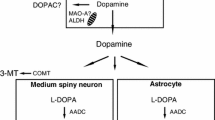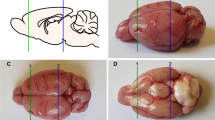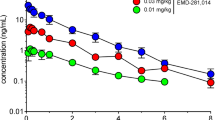Summary
Excitatory amino acid receptor antagonists lead to marked suppression of parkinsonian-like symptoms in rodent and primate models of Parkinson's disease and are able to potentiate the ability of L-DOPA to reverse akinesia and ameliorate muscular rigidity displayed in these animal models. Flupirtine, which is clinically used as a non-opioid analgesic agent, has some N-methyl-D-aspartate (NMDA) antagonistic properties in several in vivo and in vitro experiments. We now report that in monoamine depleted rats (pretreated with reserpine, 5 mg/kg, and α-methyl-para-tyrosine, 250mg/ kg i.p.) flupirtine dose-dependently (1–20mg/kg i.p.) suppressed rigidity, measured as tonic EMG activity in the gastrocnemius muscle, but had no effect on akinesia, measured as locomotor activity. In addition, it potentiated the antiparkinsonian effect of L-DOPA on akinesia and rigidity in this rodent model of Parkinson's disease. These effects of flupirtine are of particular clinical relevance, since flupirtine is devoid of the typical side effects of NMDA-receptor antagonists.
Similar content being viewed by others
References
Bergman H, Wichmann T, DeLong MR (1990) Reversal of experimental parkinsonism by lesions of the subthalamic nucleus. Science 249: 1436–1438
Birkmayer W, Hornykiewicz O (1961) Der L-3,4-Dioxyphenyalanin (-DOPA)-Effekt bei der Parkinson-Akinese. Wien Klin Wochenschr 73: 787–788
Block F, Pergande G, Schwarz M (1994) Flupirtine protects against ischaemic retinal dysfunction in rats. NeuroReport 5: 2630–2632
Brotchie JM, Mitchell IJ, Sambrock MA, Crossman AR (1991) Alleviation of parkinsonism by antagonism of excitatory amino acid transmission in the medial segment of the globus pallidus in rat and primate. Mov Disord 6: 133–138
Carlsson M, Carlsson A (1989) The NMDA antagonist MK-801 causes marked locomotor stimulation in monoamine-depleted mice. J Neural Transm 75: 221–226
Carlsson KH, Jurna I (1987) Depression by flupirtine, a novel analgesic agent, of motor and sensory responses of the nociceptive system in the rat spinal cord. Eur J Pharmacol 143: 89–99
Carlsson M, Svensson A, Carlsson A (1992) Interaction between excitatory amino acids, catecholamines and acetylcholine in the basal ganglia. In: Simon RP (ed) Excitatory amino acids. Thieme, New York, pp 189–194
Engber TM, Anderson JJ, Boldry RC (1993) N-methyl-D-aspartate receptor blockade differentially modifies regional cerebral metabolic responses to Dl and D2 dopamine agonists in rats with unilateral 6-hydroxydopamine lesion. Neuroscience 54: 1051–1061
Fahn S (1992) Adverse effects of levodopa. In: Olanow CW, Lieberman AN (eds) The scientific basis for the treatment of Parkinson's disease. Parthenon, Carnforth, pp 89–112
Filion M, Tremblay L (1991) Abnormal spontaneous activity of globus pallidus neurons in monkeys with MPTP-induced parkinsonism. Brain Res 547: 142–151
Friedel HA, Fitton A (1993) Flupirtine: a review of its pharmacological properties and therapeutic efficacy in pain states. Drugs 45: 548–569
Greenamyre JT, Eller RV, Zhang Z, Ovadia A, Kurlan R, Gash DM (1994) Antiparkinsonian effects of remacemide hydrochloride, a glutamate antagonist, in rodent and primate models of Parkinson's disease. Ann Neurol 35: 655–661
Havemann U, Winkler M, Kuschinsky K (1980) Opioid receptors in the caudate nucleus can mediate EMG-recorded rigidity in rats. Naunyn Schmiedebergs Arch Pharmacol 313: 139–144
Klockgether T, Turski L (1990) NMDA antagonists potentiate antiparkinsonian actions of L-DOPA in monoamine-depleted rats. Ann Neurol 28: 539–546
Klockgether T, Turski L (1993) Toward an understanding of the role of glutamate in experimental parkinsonism: agonist-sensitive sites in the basal ganglia. Ann Neurol 34: 585–593
Löschmann PA, Lange KW, Kunow M, Rettig KJ, Jähnig P, Honoré T, Turski L, Wachtel H, Jenner P, Marsden CD (1991) Synergism of the AMPA-antagonist NBQX and the NMDA-antagonist CPP with L-DOPA in models of Parkinson's disease. J Neural Transm [PD-Sect] 3: 203–213
Maj J, Sowinska H, Baran L, Samek J (1974) Pharmacological effect of 1,3-dimethyl-5-amino-adamantane, a new adamantane derivative. Eur J Pharmacol 26: 9–14
Mitchell IJ, Clarke CE, Boyce S (1989) Neural mechanisms underlying parkinsonian symptoms based upon regional uptake of 2-deoxyglucose in monkeys exposed to 1-methyl-4-phenyl-1,2,3,6-tetrahydropyridine. Neuroscience 32: 213–226
Moore R, Bullingham RES, Simpson S, O'Sullivan G, Evans PJD, McQuay J (1983) Comparison of flupirtine maleate and dihydrocodeine in patients following surgery. Br J Anaesth 55: 429–432
Morelli M, Fenu S, Pinna A, Di Chiara G (1992) Opposite effects of NMDA receptor blockade on dopaminergic D1- and D2-mediated behaviour in the 6-hydroxydopamine model of turning: relationship with c-fos expression. J Pharmacol Exp Ther 260: 402–408
Nickel B, Jakovlev V, Szelenyi I (1990) Effects of flupirtine, some analgesics and of muscle relaxants on sceletal muscle tone in conscious rats. Arzneimittelforschung/Drug Res 40: 909–911
Osborne NN, Pergande G, Block F, Schwarz M (1994) Immunohistochemical evidence for flupirtine acting as an antagonist on the N-methyl-D-aspartate and homocysteic acid-induced release of GABA in the rat retina. Brain Res 667: 291–294
Osborne NN, Schwarz M, Pergande G (1996) Protection of rabbit retina from ischaemic injury by flupirtine. Invest Ophthalmol Vis Sci 37: 274–280
Perovic S, Schleger C, Pergande G, Iskric I, Ushijima H, Rytik P, Müller WEG (1994) The triaminopyridine flupirtine prevents cell death in rat cortical cells induced by N-methyl-D-aspartate and gp120 of HIV-1. Eur J Pharmacol 288: 27–33
Rogawski MA (1993) Therapeutic potential of excitatory amino acid antagonists: channel blockers and 2,3-benzodiazepines. Trends Pharmacol Sci 14: 325–331
Rupalla K, Cao W, Krieglstein J (1995) Flupirtine protects neurons against excitotoxic or ischemic damage and inhibits the increase in cytosolic Ca2+ concentration. Eur J Pharmacol 294: 469–473
Schmidt WJ, Bubser M (1989) Anticataleptic effects of N-methyl-D-aspartate antagonist MK-801 in rats. Pharmacol Biochem Behav 32: 621–623
Schmidt WJ, Bubser M, Hauber W (1992) Behavioural pharmacology of glutamate in the basal ganglia. J Neural Transm 38 [Suppl]: 65–89
Scholz E, Diener HC, Noth J, Friedemann H, Dichgans J, Bacher M (1986) Medium and long latency EMG responses in leg muscles: Parkinson's disease. J Neurol Neurosurg Psychiatry 50: 66–70
Schwarz M, Block F, Pergande G (1994) N-methyl-D-aspartate (NMDA) mediated muscle relaxant action of flupirtine in rats. NeuroReport 5: 1981–1984
Schwarz M, Schmitt T, Pergande G, Block F (1995) N-methyl-D-aspartate and α-2-adrenergic mechanisms are involved in the depressant action of flupirtine on spinal reflexes in rats. Eur J Pharmacol 276: 247–255
Shahani BT, Young RR (1971) Human flexor reflexes. J Neurol Neurosurg Psychiatry 34: 616–627
Steg G (1964) Efferent muscle innervation and rigidity. Acta Physiol Scand [Suppl] 223: 1–53
Timmann D, Plummer C, Schwarz M, Diener HC (1995) Influence of flupirtine on human lower limb reflexes. Electroencephalogr Clin Neurophysiol 97: 184–188
Author information
Authors and Affiliations
Rights and permissions
About this article
Cite this article
Schwarz, M., Nolden-Koch, M., Purr, J. et al. Antiparkinsonian effect of flupirtine in monoamine-depleted rats. J. Neural Transmission 103, 581–590 (1996). https://doi.org/10.1007/BF01273155
Received:
Accepted:
Issue Date:
DOI: https://doi.org/10.1007/BF01273155




